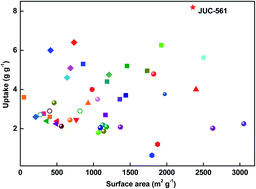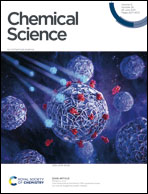Tetrathiafulvalene-based covalent organic frameworks for ultrahigh iodine capture†
Abstract
To safeguard the development of nuclear energy, practical techniques for capture and storage of radioiodine are of critical importance but remain a significant challenge. Here we report the synergistic effect of physical and chemical adsorption of iodine in tetrathiafulvalene-based covalent organic frameworks (COFs), which can markedly improve both iodine adsorption capacity and adsorption kinetics due to their strong interaction. These functionalized architectures are designed to have high specific surface areas (up to 2359 m2 g−1) for efficient physisorption of iodine, and abundant tetrathiafulvalene functional groups for strong chemisorption of iodine. We demonstrate that these frameworks achieve excellent iodine adsorption capacity (up to 8.19 g g−1), which is much higher than those of other materials reported so far, including silver-doped adsorbents, inorganic porous materials, metal–organic frameworks, porous organic frameworks, and other COFs. Furthermore, a combined theoretical and experimental study, including DFT calculations, electron paramagnetic resonance spectroscopy, X-ray photoelectron spectroscopy, and Raman spectroscopy, reveals the strong chemical interaction between iodine and the frameworks of the materials. Our study thus opens an avenue to construct functional COFs for a critical environment-related application.

- This article is part of the themed collection: Metal organic frameworks and porous polymers


 Please wait while we load your content...
Please wait while we load your content...